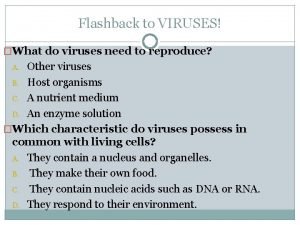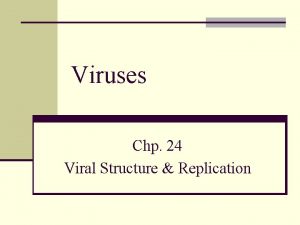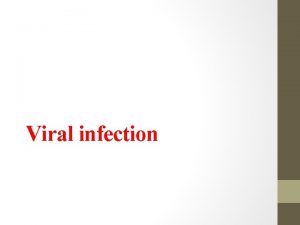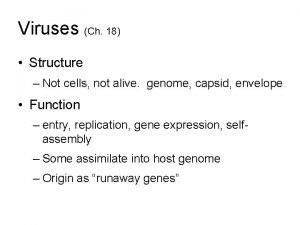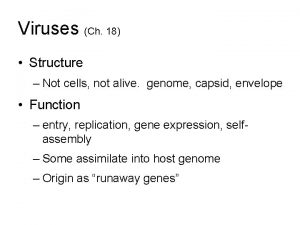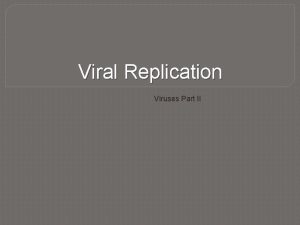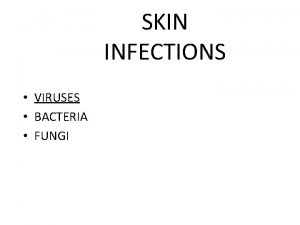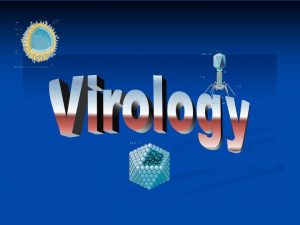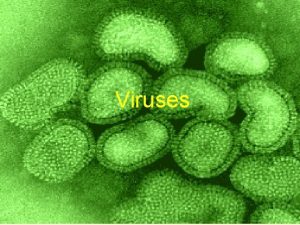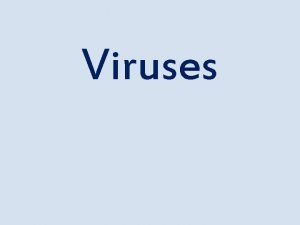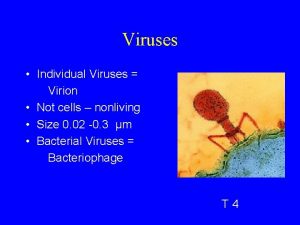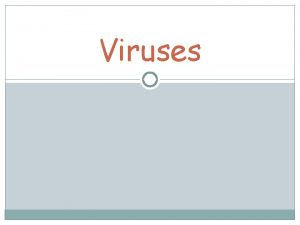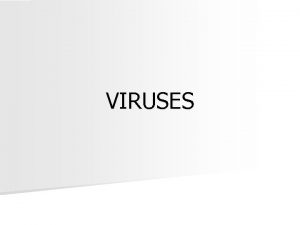Viruses Viral structure Viruses are not cells Viruses















- Slides: 15

Viruses

Viral structure • Viruses are not cells. Viruses are not considered living. (cannot reproduce by themselves- must use a HOST) • Basic structure: – Protein coat-CAPSULE or CAPSID – Nucleic acid core (RNA or DNA) – -ENVELOPE- outside protein coat in some viruses

HIV VIRUS

Virus Categories • DNA viruses – stable, do not mutate rapidly – Single-stranded or double-stranded – Smallpox, Hepatitis B • RNA viruses – mutate rapidly, unstable – Single-stranded or double-stranded – HIV, Rhinovirus

Viruses are host specific – a protein on the surface of the virus (GLYCOPROTEIN) has a shape that matches a molecule in the plasma membrane of its host, allowing the virus to lock onto the host cell.

LYTIC CYCLES Attachment Step 1 Step 3 Release Assembly Step 2 Replication

Lytic Cycle (VIRULENT- or fast acting) STEP 1 -Virus attaches to host cell’s membrane and injects its nucleic acid into the host cell. STEP 2 - The viral nucleic acid takes over protein synthesis, creating new viruses. (can infect DNA or go straight to the ribosomes) STEP 3 - The host cell bursts, LYSES, releasing the newly formed viruses.

The Lysogenic Cycle

LYSOGENIC CYCLE- TEMPERATE VIRUS or slow acting STEP 1 -Virus attaches to host cell’s membrane and injects its nucleic acid into the host cell. STEP 2 - Virus cuts into DNA and becomes part of the cell STEP 3 - When cell reproduces so does the virus (DORMANCY)STEP 4 - LYTIC STAGE when stimulus is right


How are viruses spread? AIR FOOD /WATER SEXUALLY TRANSMITTED SOIL

KINDS OF VIRUSES VIRUS Infected cells HERPES NERVE CELLS HIV T – HELPER CELLS (WHITE BLOOD CELLS) EBOLA LINING OF THE BLOOD VESSELS (INTESTINES) HUMANPAPILLOMAVIRUS (WARTS) SKIN MEASLES WEST NILE RABIES CHICKEN POX / SMALL POX PNEUMONIA

• HIV is a retrovirus injecting the enzyme, reverse transcriptase into the cell to copy viral RNA into DNA.


 M7rh5si5154 -site:youtube.com
M7rh5si5154 -site:youtube.com Unlike lytic viruses, lysogenic viruses do not
Unlike lytic viruses, lysogenic viruses do not Insidan region jh
Insidan region jh Section 24-1 viral structure and replication
Section 24-1 viral structure and replication Lysogenic viruses do not
Lysogenic viruses do not Pns water view position
Pns water view position Reabsorption
Reabsorption Thyroid gland
Thyroid gland Somatic vs gamete
Somatic vs gamete Somatic vs germ cells
Somatic vs germ cells Chlorocruorin
Chlorocruorin Is bacteria prokaryotic or eukaryotic
Is bacteria prokaryotic or eukaryotic Plant cell and animal cell venn diagram
Plant cell and animal cell venn diagram Prokaryotic cells
Prokaryotic cells Organelle trail
Organelle trail Masses of cells form and steal nutrients from healthy cells
Masses of cells form and steal nutrients from healthy cells




